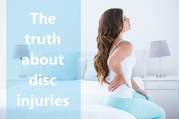
My aim with this post is to explain how your spinal discs work so you can understand how they get damaged. I will then explain what sort of injuries can occur to your discs and what sort of symptoms (if any) you can get from them. I will finish up by showing you a few things you can do to help look after your spinal discs (hopefully before they become painful). So lets get started.
A spinal disc is technically called an intervertebral disc as they sit between two vertebrae in your spine. They actually account for a third of the height of the spine and their main role is to act as a shock absorber for the spine.
When viewed from above they are kidney bean shaped (see the image above). They are flat on the top and bottom and are attached firmly to the vertebrae above and below by lots of fibres. These fibres are very strong and in cadaver studies, they have found that when placed under load, the vertebral bodies will break before the fibres holding the disc in place do. There are also numerous ligaments around the area holding it all together. This shows why a disc cannot slip anywhere, so the term ‘slipped disc’ is definitely not accurate.
The disc itself is composed of 2 parts:
- They have a tough outer fibrous layers called the Annulus Fibrosus. (Note: you will see in the image above that the front part of Annulus is thicker than the back, this is important. More on that later).
- They have a jelly-like core called the Nucleus Pulposis. It is the nucleus pulposis that gives the disc their shock absorbing nature. As we age, the gel like centre hardens and becomes less springy.
The discs have no direct blood supply
The disc itself does not have direct blood supply. To get its nutrients, the disc draws blood from the vertebrae above and below it. The key thing here is that it requires movement of the spine to achieve this.
The discs have no nerves in the center
The inner part of the disc has no nerve fibres. Only the outer third of the Annulus Fibrosus have nerve fibres. This is why a lot of people can have ‘disc problems’ but not actually know about it. Once you have 'disc pain', the problem has usually been going on for some time.
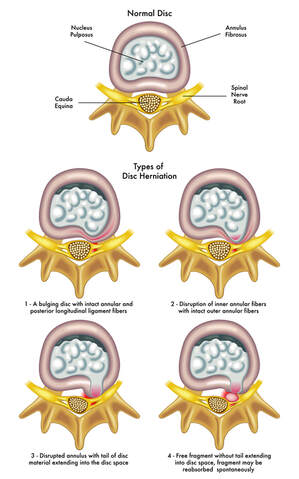
Over time through repeated poor lifting and movement, cracks or fissures can appear in the outer Annulus fibres. This allows the gel like nucleus to migrate towards the edge of the disc.
As I said earlier, only the outer third of the Annulus Fibrosus has nerve fibres, so this migration of the nucleus can occur for a while without you even knowing about it. Once these fibres are stimulated, you can sense pain.
Once irritated, these nerve fibres can then start to grow towards the middle of disc (this is your bodies way of saying "there is a problem here, I think I need to keep an eye on it").
As the nerves grow more towards the center of the disc, it takes less and less to aggravate them. I often hear people tell me that they have had problems in the past and may have a flare up once a year, but more recently these 'flare ups' have been occurring more and more frequently. Sound familiar?
As this nucleus material moves towards the edge of the disc, a bulge can form. This bulge can irritate structures in the area such as spinal nerves and in bad cases the spinal cord itself. The presence of a disc bulge can also set up a local inflammatory response giving you 'back pain'. Occasionally, some of the disc material may actually push all the way through the disc and begin to float around in the spinal canal. This is called a disc sequestration. This is definitely not a good thing.
Where do disc injuries occur?
Disc injuries are most common in the lumbar spine in the lower back, but do also occur in the neck and upper back. They are most common in men and women 30-50 years old. It can also occur in teenagers and unfortunately, this is more common these days with the poor posture a lot of kids have. I read that around 20% of teenagers have signs of disc injury or degeneration. That is scary.
A true disc bulge is unlikely to occur in older people due to the hardening of the disc material described above.
Disc injuries can occur for a number of reasons:
- A violent injury or trauma can damage a disc.
- The most common cause is a build up over time with repetitive poor movement and poor posture (especially flexing though the lower back and not the hips). These movements include sitting in poor posture, poor lifting techniques, and repetitive sports injuries etc.
- A poor functioning spine with lack of muscular support and stability.
- Sometimes there can be no apparent cause at all.
Damage to the discs often lead to degeneration. In unhealthy discs, there can be drying of the nucleus which causes the disc to 'deflate'. Think of a flat tyre, as the height of the tyre decreases, the sides bulge out. This makes the area more unstable. The bodies response to instability is to try and stabilise it by laying down bone. This is why you see bone spurs form around degenerated joints (the spurs are called osteophytes). These spurs can also irritate surrounding structures. You can see in the image below what can happen to the discs as they begin to degenerate.
We have learnt so far what the intervertebral discs are and how injuries can occur. This leads us to the important question, what are the symptoms of a disc injury?
Put simply, there can be 4 main types of symptoms of a disc injury.
- There may be no pain at all. As I mentioned earlier, lots of people have disc injuries with no symptoms.
- There can be Localized pain and restricted movement. This pain can be acute or chronic.
- There can be nerve pain. If a nerve is affected you can get radiating nerve pain in to the arms or legs. In the lower back this often causes pain that travels along the Sciatic nerve, called sciatica.
- You can also have a combination of 2 and 3.
The pain can be aggravated by prolonged sitting and certain positions such as flexion (bending forward) or twisting. It can also be aggravated by coughing/sneezing or bearing down. In severe cases, a disc injury can affect nerves that control the bowel and bladder, which can lead to a loss of control. If you do suffer an injury which affects your control of the bowels and bladder, this is a medical emergency and needs to be assessed as soon as possible.
There are lots of things you can do to look after your spinal discs. In this post I am going to show you 3 of these.
1) Move your spine
As I said earlier, your discs require movement of the spine in order to draw nutrients from the vertebrae above and below. The more you can move your spine the better. A good way to do this is the yoga exercise cat/cow. This is a nice exercise to get some movement through the spine without the compressing nature of gravity. When you do this make sure are not pushing it into pain. Stay in your pain free range. The video below shows how to do this.
Recent studies have highlighted the fact that the simple act of walking is often just as beneficial as the most rigorously tailored spinal stabilisation exercise approach. One particular study found that a 6 week walk training program was as effective as 6 weeks of specific strengthening exercises for the lower back. Interesting hey?
Simply going for a good brisk walk is great for your spine. Faster walking is better at activating the muscles in the lower back than a slow walk. Even better, walk on an uneven surface to really activate the proprioceptors in the body.
3) work on your posture
One of the best ways to look after your spinal discs is to make sure your posture is good, especially for the lower back. The main thing to try and avoid is flexing or rounding the lower back for prolonged periods of time.
Rounding the lower back puts tension on the back part of the disc. If you look at the image of the disc above, you will see that the back part of the annulus is thinner than the front. When we are in 'ideal posture' this back part of the disc will be under compression and the front part will be under tension. If we then round our back, these forces are reversed and our discs are just not designed to cope with these for prolonged periods of time.
I think that the amount of disc problems and back pain that is around these days is due to the fact that we spend a lot of time in that flexed or rounded back position (think computer work, sitting in cars, looking at phones etc).
So simply trying to avoid this position is only going to be good for your discs.
If you have back pain or a possible disc injury and would like to have it assessed, feel free to contact me to arrange a time for an assessment. I would be happy to help out.
References
https://cdi.edu.au/clarity/is_walking_enough.php
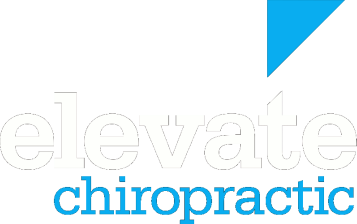
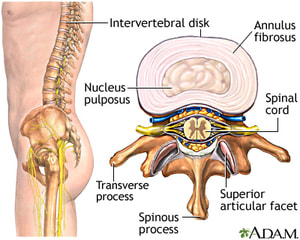
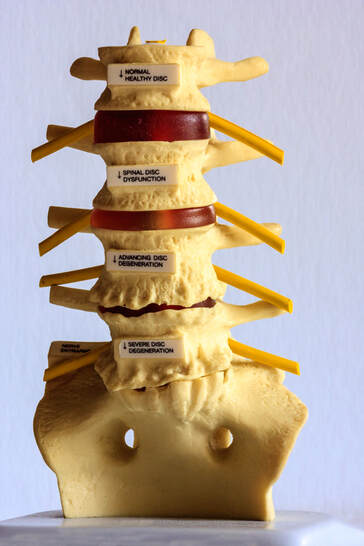


 RSS Feed
RSS Feed


